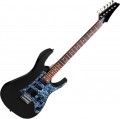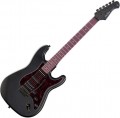Neck profile
Profile of a fretboard mounted on an electric guitar.
The profile of the neck is called its shape in section, more precisely, the shape of the back of the neck. This parameter practically does not affect the sound of the guitar, but it directly affects the convenience of playing. Ideally, the neck should “fill” the hand, but not be too large — otherwise it will not be possible to clasp it to the right extent.
Profiles are denoted by the letters C, D, V and U — depending on which letter the neck resembles in the section. Profile D is the flattest, C is slightly more convex, with almost uniform curvature along the entire length, U is more voluminous, with a wider profile in the area of the lining, and the V profile in its classic form has the form of an angle with a rounded top. There are also modifications of these options — for example, "thin", which provides for a reduced profile thickness, or "modern", with slightly improved (theoretically) ergonomics.
The most popular profile types are
C,
U and their "modern" (modern) modifications. The C profile is almost semi-circular, the U profile is more voluminous, at the fingerboard its edges are almost parallel and only closer to the back of the neck are sharply rounded. The terms
modern C and
modern U refer to various improved versions of these profiles, their f
...orm may be different.
In fact, the choice of neck profile depends solely on the guitarist's personal preferences, the characteristics of his hands and his preferred playing technique. Thus, there is no "perfect" profile shape — in each case, the optimal choice will be different. The perfect option is to try several types of profile "live", decide which one will be more convenient, and choose an instrument with a neck of the same or similar profile shape.Nut width
The width of the fretboard of an electric guitar at the nut. Closer to the body, the neck may expand somewhat, but this is not necessary, and the expansion angle may be different. Therefore, the main size is considered to be the width in the region of the nut.
This parameter has two meanings. On the one hand, a wide neck is inconvenient for musicians with small hands and short fingers — it can be difficult to reach the far strings in such cases. On the other hand, a larger width means a greater distance between the individual strings, which reduces the likelihood of hitting an adjacent string when pressed incorrectly and can make playing easier (especially if the guitarist has large fat fingers). However, these moments are not absolute, and the convenience of playing is a very subjective matter, depending on many features of the musician and the technique he uses. Also, don't forget that necks can have different profiles (see above), and instruments with different neck profiles will feel differently in the hands even with the same width at the nut. Therefore, the most reliable method of selection is to try out the necks of different sizes and profiles “live”, decide on the best option and choose based on this.
The smallest neck width at the nut in modern electric guitars is about 39 mm. This size is found mainly in bass guitars (see “Type”), which have 4 strings and a neck that widens noticeably towards the body (due to which it can be made rather narr...ow from above, especially since when playing bass, notes are rarely clamped near the neck itself) . Electric guitars (including semi-acoustic) are somewhat wider — from 41 mm, an indicator of 43 – 48 mm is considered average, and in the largest instruments, the neck can be up to 55 mm wide (however, such dimensions are typical mainly for instruments with more than 6 strings) .
Fretboard radius
The radius of curvature of a fretboard mounted on the fretboard of an electric guitar.
The fingerboard is located directly under the strings, it is to it that the musician presses the strings when playing. If you look at the neck in cross section, its upper part with the overlay will have the shape of an arc; the radius of this arc is implied in this case. The smaller the radius, the more convex this arc will be, and vice versa, a large radius will correspond to an almost flat surface.
In general, it is believed that a smaller fingerboard radius is better for playing chords, and a more even, flat surface makes it easier to play technical passages with an abundance of special techniques such as bands. The average and, one might say, classic diameter value is 12", this is the most popular option among modern electric guitars. The smallest figure is just over 7", it is found in some guitars with Stratocaster bodies (both original Fender instruments and copies ). And the most flat pads have a diameter of 20" or more.
Note that there are often instruments with a variable fretboard radius — smaller at the headstock (where chords are played more often) and larger near the body (where solos are played by notes). In such cases, the radius at the nut is indicated.
Anchor
The type of truss provided in the design of the neck of an electric guitar.
The anchor has the form of an elastic metal rod installed along the neck and hidden inside. It reinforces the structure and prevents the neck from deforming from string tension. The truss rod can be made adjustable to suit the characteristics of the strings and compensate for the deformations that inevitably occur over time. The types of this detail can be as follows:
- Single. Anchor consisting of a single rod. The classic version used in most modern electric guitars, regardless of price category. Usually, the strength and rigidity of even a single rod is sufficient for normal applications and use.
- Double. Anchor, consisting, in accordance with the name, of two rods. It is distinguished by greater strength and reliability compared to a single one, in particular, it provides additional resistance to lateral deformations. On the other hand, the double construction is noticeably more expensive.
Fretboard
The material from which the fretboard of an electric guitar is made.
The fretboard is placed under the strings, where the strings are pressed when played. The need to use overlays is due to the fact that the types of wood from which the fingerboard itself is made are often not hard enough, and dents could occur on their surface from constant contact with the strings. Accordingly, the overlays are made of a harder material that retains the shape of the surface even after repeated pressing of the strings. As such a material, both special types of wood (
ebony,
rosewood) and high-quality phenolic polymers can be used.
In general, the quality of the fingerboard is usually quite consistent with the price category of the instrument, but it hardly makes sense to dwell on the detailed characteristics of each material (they are not so critical for the normal use of an electric guitar). We only note that the material of the overlay directly affects the appearance of the instrument.
Strap
Shoulder strap included with electric guitar.
The strap not only allows the musician to play while standing, but can also come in handy in a sitting position. This is due to the fact that electric guitars (unlike acoustic ones) have a relatively small body thickness, and often also a specific shape; as a result, it can be difficult, if not impossible, to keep such an instrument on your knee without additional support. And even for semi-acoustic instruments (see "Type"), where this moment is not so pronounced, an additional "suspension" on the shoulder may be useful. Thus, an electric guitar strap is highly desirable anyway, and its presence in the kit can be very convenient — you don’t have to look for this accessory separately. On the other hand, almost all tools use the standard strap attachment, and the included strap may not be the correct length or design. Therefore, this configuration option is extremely rare, mainly among low-cost models — it is assumed that sophisticated guitarists prefer to choose a strap on their own, according to their own preferences.
Picks
A set of
picks is included with the guitar.
A pick is a small plate used when picking sound from strings. Using such a plate provides a more pronounced, accented sound than playing with fingertips; in addition, it is easier to use a plectrum to "metre" the effect on the string in terms of strength and sharpness. Thus, this way of playing is used by most guitar players, including world-class stars.
If picks are included in the package, then there are usually several of them — of different rigidity; thus, the guitarist can choose the most suitable option, depending on his own preferences and the characteristics of the technique. However, such equipment is rare and is typical mainly for low-cost instruments designed for beginners (of the “my first electric guitar” format). This is due to the fact that more or less experienced musicians often prefer not to rely on the choice of the manufacturer, but to purchase picks separately, in accordance with their own criteria.

